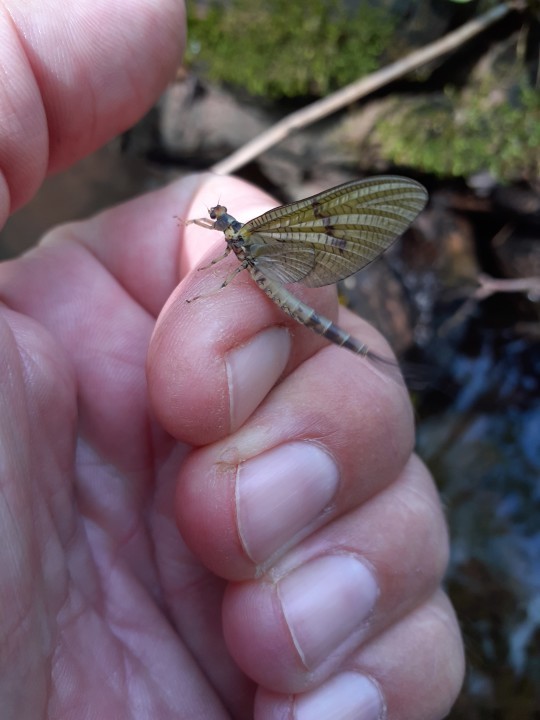 Mayfly - JA from Leominster
Mayfly - JA from Leominster During the last week of May the eponymous hatch of big white flies was coming into blossom and for a couple of afternoons I saw some excellent mayfly fishing on the Lugg and Arrow. Then I was called away to a family wedding in Sussex and we stayed in Hilaire Belloc country, living in an old pub overlooking the Rother towards the South Downs. No mayfly here that I could see, but they do have brown trout in the mostly slow and murky waters of the Rother (the pub has a stuffed one of 4.5 pounds) and the river is known for its sea trout also.
However, when we got back home, some anglers on border streams were already complaining that the mayfly had slowed down rather and we had reports of more difficult days. It seems now that we have had much better mayfly seasons in our local streams than this one and perhaps the strangely cold spring may have had something to do with it. We can expect June to be a month of blazing heat, but this June of 2021 was hardly that. Instead we had cooler days, windy days, and almost continuous clouds which often threatened rain. We certainly had some showers and Eastern England had more, but not that much water ever fell on our catchments so that our rivers remained low.
At the same time our friendly keeper Peter Major at Heale on the Wiltshire Avon was already claiming that 2021 is the best mayfly season he has seen in his 20 years on the river. David Burren and I did manage a day on the Avon early in June and there were plenty of duns, a few spinners left over from the previous evening and definitely enough rising fish to go at. The curious thing was that in the faster water below hatches, if you saw a fish rise and popped a fly over the spot, you were pretty sure of an immediate response, but in the slower glides above, a result was much less certain. Closer inspection revealed that the fish in the impounded sections, rather than remaining on station, were cruising around sipping in mayfly here and there, and as likely to be moving downstream as upstream. I used a Monnow Gosling all day and by working at it found you could get a fly in front of them sooner or later. We ended up with 18 trout to 20 inches between us, plus a couple of out of season dace.
Back to the wilder rivers of the Welsh border, and on the 2nd HS from Hassocks with a friend had rain during the afternoon at Dinas and went on to experience “a wonderful evening rise to tricky fish.” That sounds like the typical Usk all right and by the end of the day they had caught 8 trout. Over on the Wye salmon angler GO from Brecon hooked into “one of the hot ones” in the Rock Pool at the Rectory. After a certain amount of drama, this big salmon was netted and pulled scales down to a 22 pounds stop with a bump. PB from Salisbury was fishing at the Glanusk Ty Mawr / Canal and Rivers Trust water below Brecon and recorded a 3 pounds trout in a bag of 6 while nymphing in pocket water. AG from Bognor with a friend was up on the wild moors at Llyn Bugeilyn where as a pleasant surprise they found the access road improved. They caught 19 trout between them. Meanwhile EC from Kingsley was not pleased with the Merthyr Tydfil Angling section of the Taff the following day, “not rural, nor idyllic.” To be quite fair and having re-read the description of the beat, I am not sure why anybody would imagine it would be. Some miracles have been achieved with the rivers of the Welsh valleys, which were once no more than poisoned industrial drains. However, for all the insect and fish life in the water, the urban landscape is never far away, although some more bosky sections of the Taff are quite pretty. For local anglers, the whole restoration was a huge achievement. Visitors who may be travelling some distance will need to consider whether they care more about the fishing or the proximity of roads and houses. That, I suppose, is true of all urban fishing.
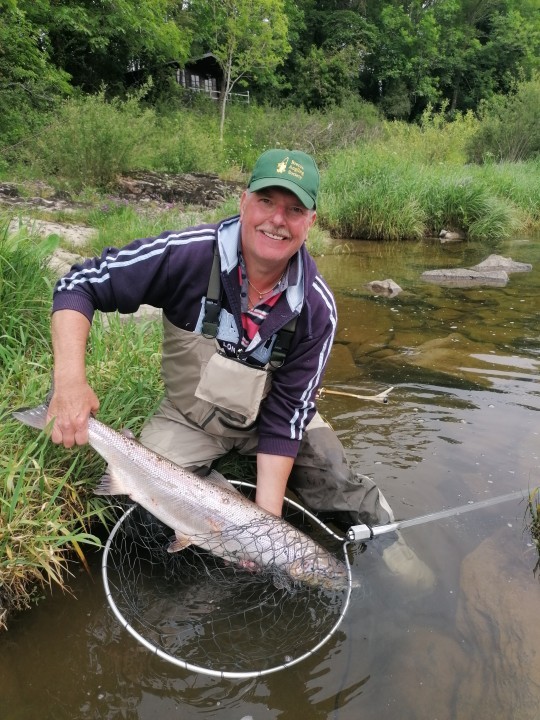 Rectory salmon - IW from Brecon
Rectory salmon - IW from Brecon 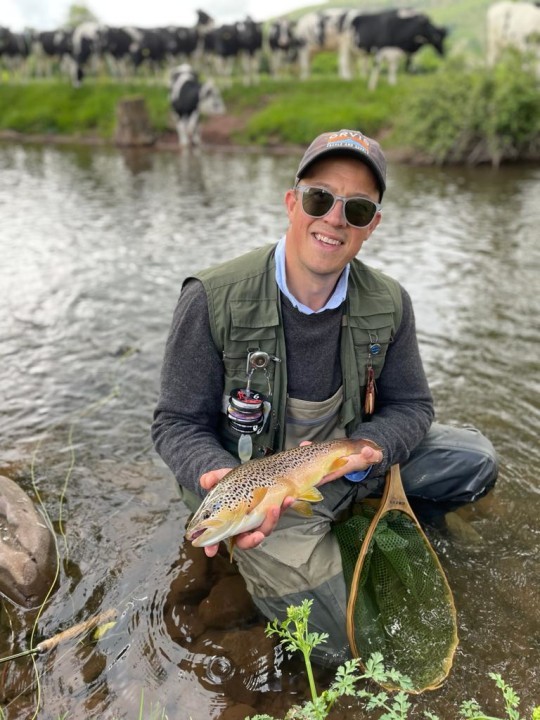 Lower Stanton - JS from Oxted
Lower Stanton - JS from Oxted News from the North came on the 3rd, when NL from Gateshead with a friend caught 20 trout on dry flies from the Tees at the Raby Estate. On the Usk, PD from London had a terrible time wearing rubber soles on the slimy rocks of Cefn Rhosan Fawr. He came to the right conclusion: you need felt soles with studs to fully explore our rivers and nothing else really compares. MN from Bristol fished the same beat for 6 trout to 18 inches using long leader nymphing. The river was low and clear and nothing was rising. JS from Cheltenham fished the Honddu at Lower Henllan on the 6th and remarked that there is no mobile reception on the beat so if you have failed to download the WUF directions in advance you will be in trouble. How true! This may seem terribly old-fashioned, but I still ask my clients to print off the ticket, map and directions before meeting me for fishing – it does save an awful lot of problems and is a sure way to avoid lost anglers wandering around the countryside peering at unresponsive devices! I don’t think I’m thereby responsible for the felling of many extra trees; you can always use the same map on the next visit.
CT from Cardiff was quite annoyed with what he described as “appalling access” to the Olchon Brook on the same day. He caught a fish on the junction pool with the Monnow before going on to fish elsewhere. CT knows our wild streams quite well, so he won’t have spoken lightly. I haven’t seen the Olchon this year, but it was in a bad enough state last year, overgrown and wired across. This is an adopted beat according to my notes, so will it be possible for WUF to contact the adopter or perhaps find another one? On the 6th JS from Oxted took 8 trout from the Honddu at Lower Stanton, remarked how surprisingly big some of them were and wondered why they were present on such a small stream? Others have asked the same question. I remember being quite surprised by a brown trout capture many years ago when I first fished it and going so far as to ask at the neighbouring trout farm which was then working. The management there swore they had never produced anything more than small rainbows for supermarkets. I suppose a supply of trickling trout pellets might have something to do with it? Let’s not complain.
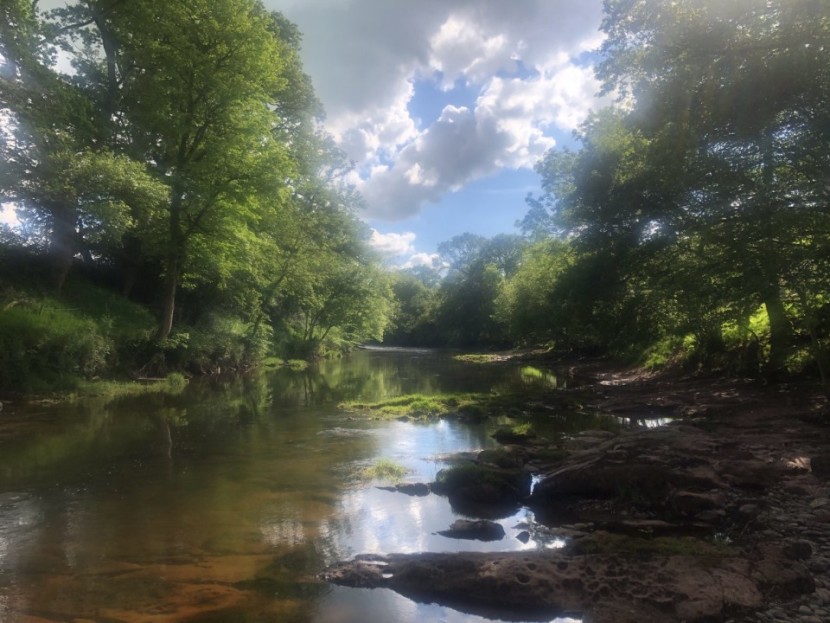 Fenni Fach - JB from Uppingham
Fenni Fach - JB from Uppingham 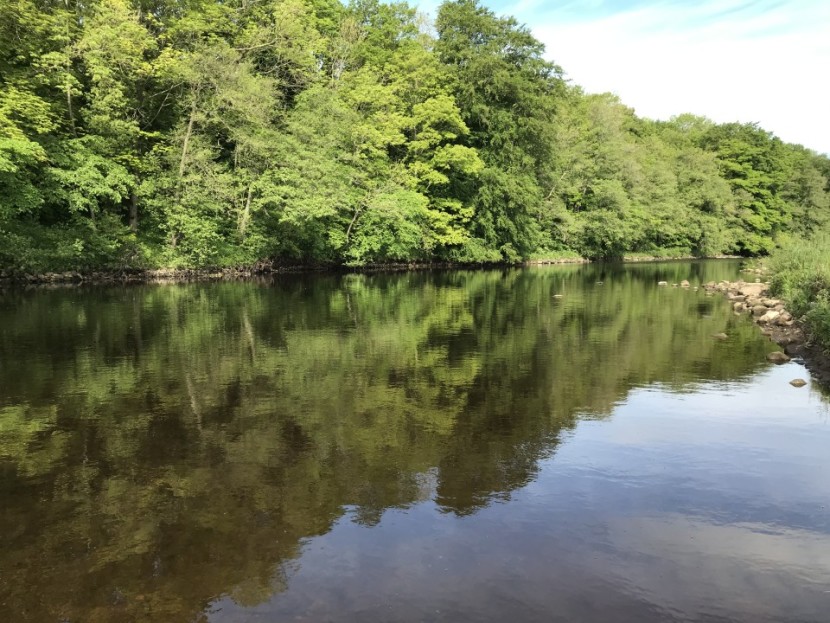 High Coniscliffe on the River Tees - ND from Coxhoe
High Coniscliffe on the River Tees - ND from Coxhoe NO from Woking reported 7 trout to 14 inches from Fenni Fach on the 7th, while JA from Leominster had 9 fish to 11 inches from the Arrow at Kington. TG from Consett had 20 trout from the Tees at Raby Estate. SL from Looe with a friend had just the one good trout of 1.5 pounds from Glanusk Ty Mawr / Canal and Reservoirs Trust, but quite appreciated the sight of two young ladies they found swimming there. On the other hand, there was actually a complaint from other anglers about bikinied ladies with English home counties accents (my italics) encountered in the river further upstream. Would this encounter have been more acceptable if they had been Welsh-speaking, I wonder? PK from Bromsgrove had problems with the access at Arrow Mill, barbed wire being combined with electric fencing to keep him out of the water. Salmon anglers were by now complaining about the colour of the Wye, dirty water running out of the Ithon being held to blame. This cleared to some extent after a few days, possibly due to the lack of sun. IW from Pontyclun caught 12 trout from Fenni Fach. Meanwhile, back on the Tees at the Raby Estate JW from Darlington with a friend accounted for a large catch of 35 trout. CT from Cardiff with a friend caught 30 trout from 6-14 inches with nymphs at Aberedw on the 9th. 14 inches strikes me as a pretty good size for the Edw. JA from Leominster had 8 from the Arrow at Kington and the following day AF from Nailsworth had 10 trout to 11 inches from the same river at Hergest Court, mainly with a Grey Wulff dry fly. GB from Tenbury Wells had 10 trout and 3 perch fishing in Usk Reservoir in a wind on the 11th, while NO from Woking recorded 8 Usk trout from Fenni Fach.
 Cefn Rhosan Fawr trout - MN from Bristol
Cefn Rhosan Fawr trout - MN from Bristol 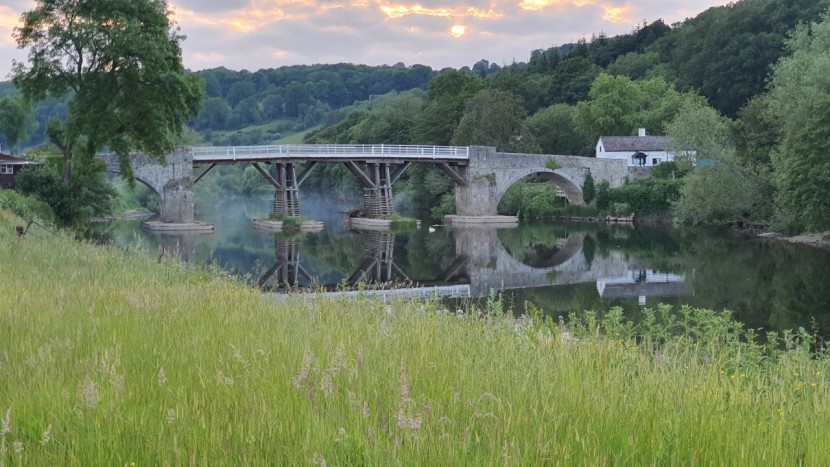 Wye toll bridge at Whitney - SH from Leicester
Wye toll bridge at Whitney - SH from Leicester 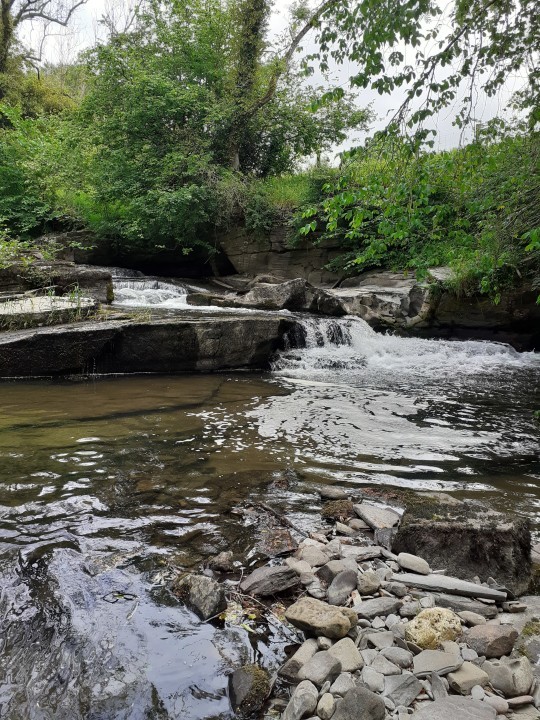 Edw Hergest - JA from Leominster
Edw Hergest - JA from Leominster EG from London sent in a long report about the Teme at Bucknell on the 12th and had much to say about the supposed need for a GPS and the difficulty in establishing the upper and lower boundaries of the beat and also in accessing the river. He also mentioned a collapsed bridge. Unless it is quite new, to the best of my knowledge there has never been a bridge on the Bucknell beat. At the risk of repeating myself, the simple answer is to print off the directions and map sent by the Foundation with your ticket, take it with you and read it.
One angler who was not pleased with his day was AS from Blackwood, who on the 12th recorded a blank at Llwyn On Reservoir. Firstly he thought a ticket for an adult and child at 18 pounds plus 3 pounds booking charge was “a rip-off.” I suppose we could argue about what a fair price is, including the cost of stock fish, but I note that this was the second time in a week AS had bought a ticket. I would also ask if there is to be no booking charge, how will the costs of the online booking system be met? AS also alleged that the bailiffs were lying when they told him 500 trout had been stocked the previous Wednesday. I suppose I could wearily take up cudgels on behalf of the impugned good character of the Water Company’s bailiffs…but is it really necessary? I mean why would they bother? Could it be, I wonder, that AS’s lack of success on a bright, hot day is what is really troubling him? He tells us he is not minded to visit again. I suppose everybody can’t be pleased.
BP from Pembridge reported 9 trout from the lower beat of the Llynfi Dulas, and also an out of season grayling…which was higher up the system than usual. LB from London had a catch of 10 trout from the Abergavenny Town Water on the 13th. On the following day PF from Kennilworth was disappointed at Goodrich Court by visibility of just 12-18 inches, although fresh silver salmon were showing regularly. Several other anglers on the lower Wye were now complaining about the stain of colour. LT from Creigiau with a companion was fishing his regular stint at Chainbridge on the Usk and wondered why there was no evening rise? I can only comment ruefully that a rise to hatching insects is not absolutely guaranteed at any time of day and an element of luck is always going to be involved! Recently I arrived mid-morning on the upper Wye with a client to find fish rising all over the beat. All very good, but my client was a beginner and first had to learn to cast. So we spent time on the shallows doing just that while fish rose all over the place. However, by the time we had got some casting established (she was a quick learner), the rise was just about over, despite the fact that the day was cool and cloudy. We spent the rest of the time going at occasional “oncers” with spiders and managed to put a modest bag together.
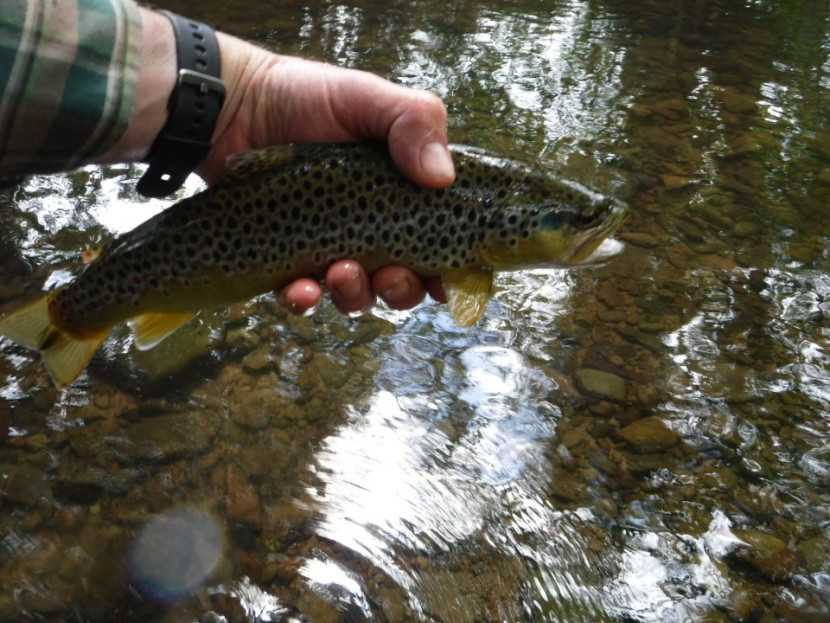 Llynfi Dulas lower - BP from Pembridge
Llynfi Dulas lower - BP from Pembridge 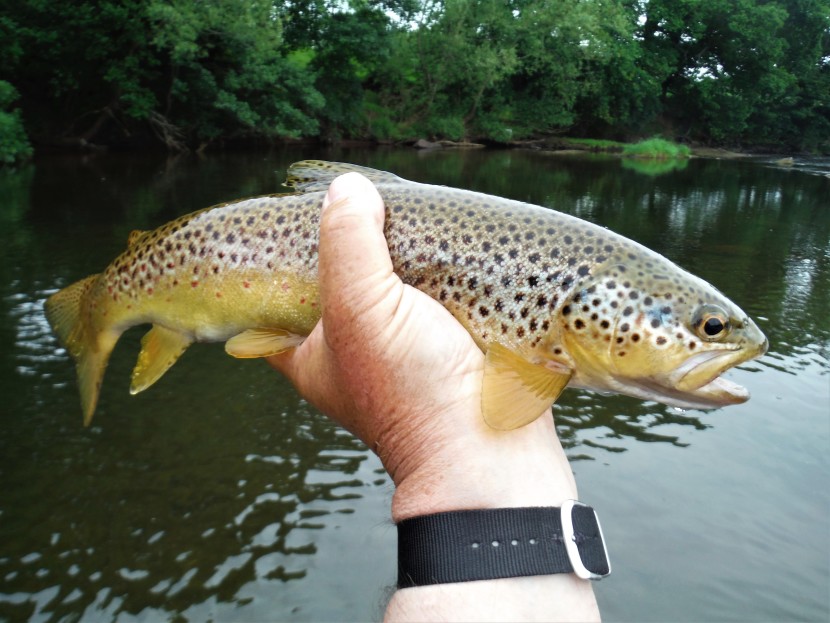 Blue winged olive feeder
Blue winged olive feeder On the 16th grayling came into season and the coarse fishermen began to enjoy themselves on the middle and lower Wye. JA from Leominster had 8 trout from 7-10 inches from his regular Arrow beat at Kington. NM from Conwy reported a dozen trout taken on a leash of traditional wet flies from Llyn Eigiau. JA from Leominster also reported a dozen to 12 inches from the Edw at Hergest on the 18th .TLQ from Alresford with a friend had 15 trout between them from Abercynrig. The weather was cooler now and cloudy, which may have helped the results a little. On the 18th MN from Bristol tackled difficult low water on the Irfon at Cefnllysgwynne with dry fly and duo at a distance, and managed 8 trout to a creditable 17 inches. Fishing the same beat the following day, he took 5 trout and 4 grayling around 16 inches each on nymphs. GM from Shrewsbury had 8 trout from Dinas while BP from Pembridge had 8 trout and 3 grayling from the Llynfi at Talgarth. GW from London with a friend had 20 trout on nymphs from the upper Usk at Penpont, and the following day used the same method to take 22 trout and 15 grayling from the Wye at the Rectory. Simon Evans from the Foundation had a good evening on the Usk below Llanellan with blue winged olives hatching, and caught 9 trout to 2 pounds 4 ounces. He had a fish of 3 pounds 12 ounces the previous week. To change the theme a little, AG from Clyro caught 3 sea trout from the Aberystwyth AA water of the Rheidol and lost a number more. I also had reports of a few sewin from the Towy and Loughor, mostly fish of about 3 pounds.
 Arrow at Whittern - PY from Hereford
Arrow at Whittern - PY from Hereford 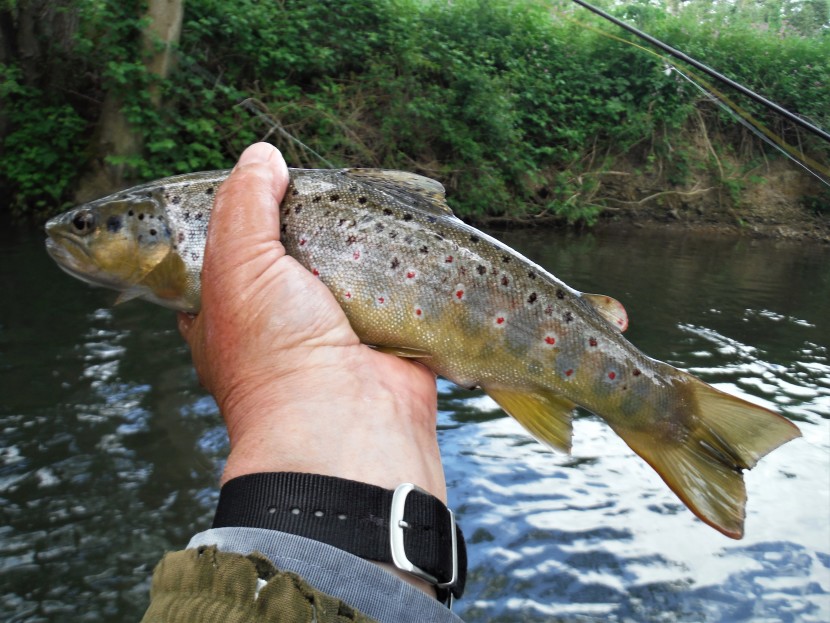 Whittern trout
Whittern trout Regular small stream angler JA of Leominster caught 10 trout from the Llynfi Dulas middle beat on the 21st, but had perhaps understandable criticisms to make about the encroaching vegetation, “messy,” as he described it and suggested that WUF “…stick it on your to do list.” Now here’s some information for small stream aficionados who imagine that WUF have a team of pruners and trimmers standing by ready to be called into action. I’m afraid the news is that there isn’t such a team and there isn’t funding for one. Nor can we really expect farmers / landowners who gain only a tiny income from these little streams to do much in the way of maintenance. In practice, we have always found that what pruning does get done is by volunteers, keen small stream anglers who live within the general area or fish a particular stream regularly. Believe me, over the years I have turned out more than once on winter days to trim the Llynfi Dulas middle beat, not to mention the upper beat when we had it, the lower beat, and also the Talgarth section of the same stream.
Now, here’s the thing: we started the volunteer scheme a decade ago with a group of chaps described fairly accurately then as “Dad’s Army.” Time has moved on I am afraid, much water has flowed under bridges, hair has greyed and shoulders are more bowed. I am 70 years old myself and some of my erstwhile team mates more than that; others are not so fit; one or two have even popped their clogs. It strikes me we could use a little help. Meanwhile, those overhanging branches keep on growing. The latest variation to the scheme, and I think it is a good one, is that each individual volunteer adopts one or two local streams and maintains them with at least an annual trim. I do the three beats in the Forest of Dean and have done for many years. It would be nice to think some younger anglers might be volunteering soon to carry on the good work during the next close season? Over to you JA; do you think you could spare some time this winter? Just call in to the Foundation or contact me and I’m sure we can find something for you.
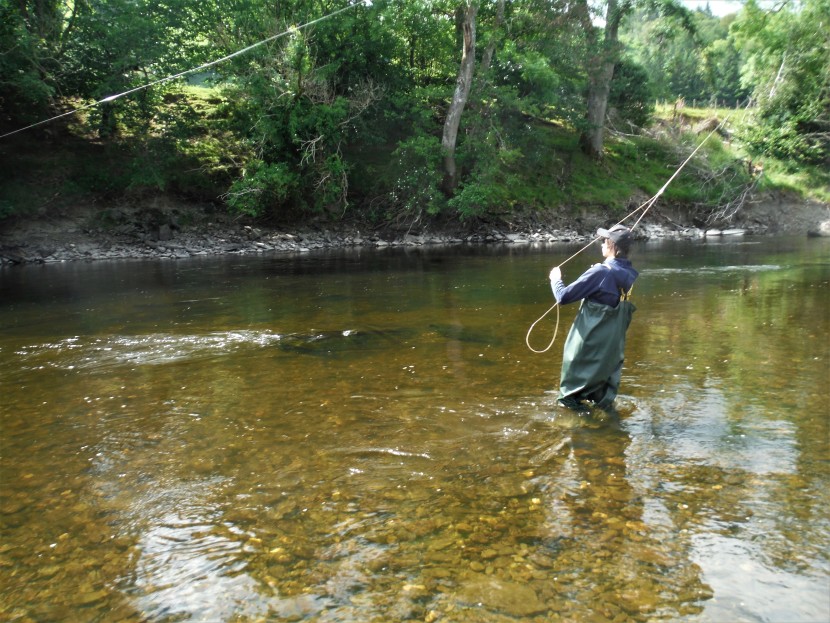 14 year old Maelo Garrigues works on his casting
14 year old Maelo Garrigues works on his casting  And a result!
And a result! For a long period very little was happening for the Wye salmon anglers, although cooler weather and high tides produced a few silver fish for Wyesham at the bottom end. However, coincident with the spring tides in the last week of the month, one of our committee members from Pontardulais AA in a session on the little River Loughor released two double-figure salmon and lost a sewin of 6 or 7 pounds. From North Wales NM from Conwy reported 8 trout as well as an arctic char from Llyn Dulyn. It isn’t often that we see char in the reports. On the 24th JD from Bromyard caught 8 trout at Hergest Court and watched an otter at close hand. I do believe that otters are a bit short-sighted; they may come quite close if you stay still.
On the same day TL from Kingsland apologised for catching 10 grayling as well as 2 trout at Eyton. Well, no need to apologise, because grayling are now in season and have been legal to catch from 16th June on. However, they aren’t always at their best so soon after spawning and I have seen a few in quite poor condition with particularly ragged and loose scales. By September and October and on into the winter, however, they should be fighting fit. MS from Bangor caught 3 grayling along with a couple of trout from Craig Llyn with a very old-fashioned dry fly. This was Rolt’s white hackled Grayling Witch, a beautiful name for a century-old design. DG from Hereford had some complaints to make about barbed wire blocking access to the Middle Senni, a rarely visited Usk tributary. MG from Hereford had 7 trout and 3 grayling from the main Wye at Gromaine. Meanwhile, the coarse anglers on the lower Wye were really getting stuck in, reporting plenty of barbel and some huge catches of chub. Resident salmon had been showing at Goodrich Court for weeks, but a 12 pounder was caught by Mark Drummond on the 28th and a 26 pound cock fish by Mick Sutton on the following day. Fresh fish, including grilse, were now beginning to turn up on the beats below Monmouth.
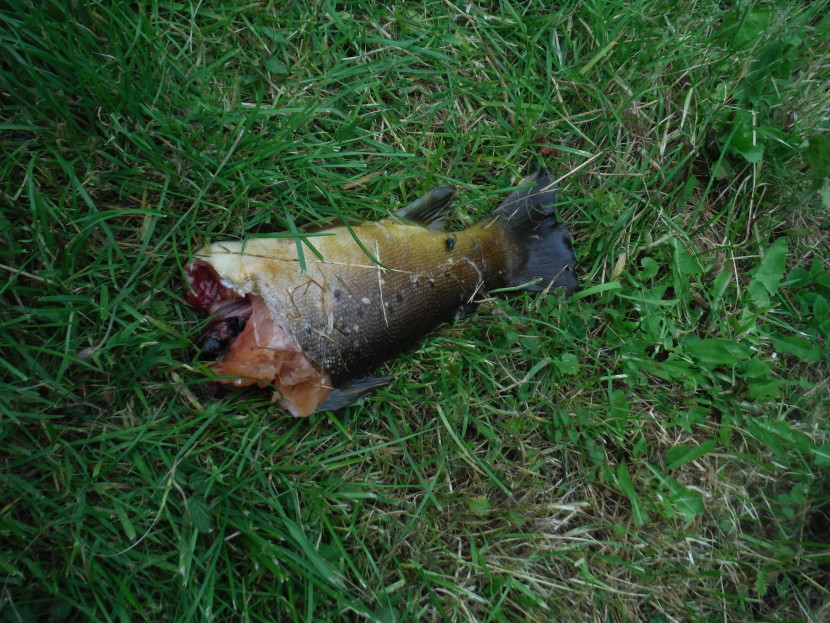 An otter has visited
An otter has visited 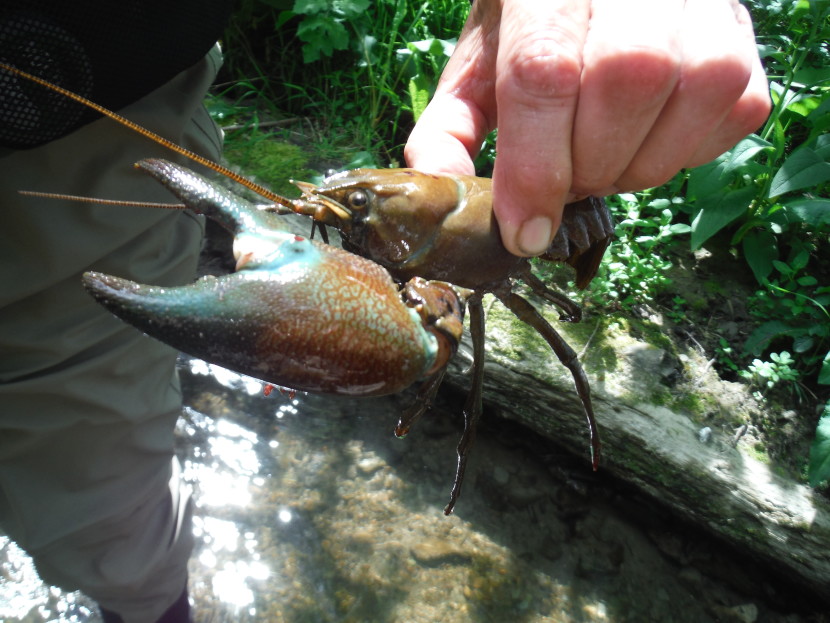 Formidable even with one claw
Formidable even with one claw During the month MD from Ross who was fishing the Usk at Chainbridge complained about no less than 5 trespassing kayaks passing him during the day, as well as contending with a poaching family from the caravan site who argued that “the man who owns the fishing” had given them permission on the phone. Now I know the man who owns the fishing, and I can promise you that little story was not true! Then we have the case of the anglers booked on at Abercynrig who like to sneak up above the boundary and fish a bit of Dinas as well. You know who you are! The trouble is, you know, that you can be seen from the by-pass bridge.
The other evening at Goodrich Court the 100th canoe of the day came gliding down the Vanstone Pool and we legitimate anglers suddenly realised that the two chaps in it were lobbing spinners out left and right. They had a big net with them and I dare say they had a significant chance of a salmon. I’m afraid I failed to get a photograph of them; they did desist for a while when shouted at, but I imagine they helped themselves to all the beats below. While shooting at Keeper’s Lodge the following morning, I was told that they also poached their way down through Thomas Wood. Much modern poaching consists of minor pieces of nonsense like that, although more serious industrial-scale poaching does exist and is much less pleasant to deal with when you come across it. And by the way, I have an admission to make myself this month, in that I failed to look properly at the bookings the previous evening before taking a morning on the Bideford Brook. As a result I managed to poach the water of two very pleasant gentlemen from the Salisbury area, who had booked it in advance. They were very nice about it at the time, but once more I must humbly apologise, particularly as I tend to criticise that sort of behaviour in others. “Alas for human nature, especially other people’s,” has always been my motto.
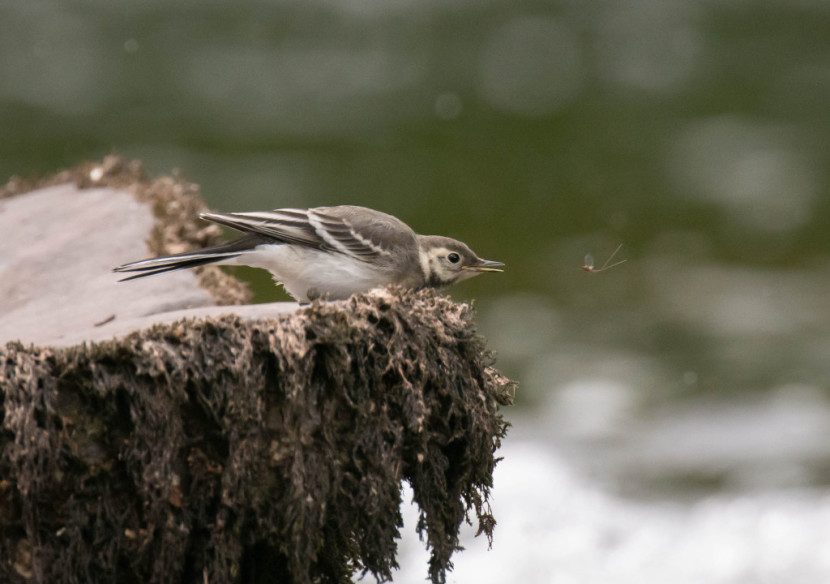 Abercynrig - CN from Berkeley
Abercynrig - CN from Berkeley Generally the problem with the public perception of poaching has always been the legend of that “Lincolnshire poacher” character who is a bit of a rascal, and inspires mostly humour and affection for the way he manages to put one over on the supposedly over-privileged estate owner and his keeper. Some of the literature has hardly helped. John Buchan was one of the many writers who could not resist the idea of romanticizing poachers and poaching. In his otherwise rather unremarkable novel John Macnab, published in 1925, the plot involves three friends who find themselves bored during a long summer holiday in the Scottish highlands. What these three claim to have been missing since the War is some real excitement with an added element of danger. (You might imagine that most people who survived the Great War to live on into the 1920s, rather than missing any imagined excitement, would have been grateful to be alive. However this was the way John Buchan portrayed his protagonists). The idea these three sporting gentlemen come up with to enliven their holiday is a poaching challenge: to grass a salmon from the river of one of the neighbouring estates, and within the same 24 hour period to kill a stag on a neighbour’s hill. To make it more sporting, they opt to send round a letter warning of their illegal intention signed by a fictitious “John Macnab.” Buchan has a bit of fun describing the old money and new money characteristics of the estate owners concerned, but they rise to the challenge with keepers sent out to watch the moors and the river. The three friends really are taking a risk, mainly with their respectable reputations: one is an MP, one a serving cabinet minister and the other a former Attorney General.
I can’t remember the twists and turns of the plot, but there is some love interest as usual with Buchan and I think it ends happily. The novel had enough impact to start what became a long-standing tradition for the more competitive rural sportsmen in our country, something a bit like the “grand slam” of three species in tropical fly fishing. Thus a “John Macnab” is to shoot a stag and a brace of grouse, and then catch a salmon, all within a 24 hour period. For those who miss the illicit and poaching element of the original story, scoring a “Royal Macnab” would involve the three above mentioned species plus your host’s wife. There is even something I think is called a “Royal Flush Macnab,” which includes the cook. But that may be just a legend.
Incidentally the name of John Macnab, the poacher who never existed, lives on in another way. The entrepreneurial gunsmith Patrick Keen of Brampton Abbots near Ross on Wye had a talent for marketing shooting equipment from Europe in this country. Eventually he realised the excellent idea of commissioning over and under shotguns from the Italian firm Sabatti in the famous Gardone valley, a region which has been making gun barrels since the Middle Ages, and selling them in the UK under the brand name John Macnab. You still see second hand ones around this part of the world and they are supposed to be good, workmanlike guns.
I have been watching the launch of GB News, Britain’s new centre-right broadcaster, with some interest. As you might expect, some of the technical aspects were rather clunky at first, with inexplicable pauses and a need for constant sound volume adjustments by the listener. And I have mixed feelings about the style of some of the presenters, including Dan Wootton with that perpetually pasted on Tony Blair smile and his habit of interrupting the people he is interviewing. Simon McCoy, as you might expect, provides a safe pair of hands. Station Chief Andrew Neil, however, is a class act and has already showed flashes of brilliance, particularly when sparring with Rishi Sunak.
Andrew Neil has quite a few years of journalism under his belt now, and this is rather like watching an ageing cowboy set off on his last round-up. To extend and perhaps confuse the horsemanship metaphor, he clearly sees it as his mission to tilt at the “windmills of wokery” at every opportunity. Some will be horrified by this (hence the attempts to shut the station down by cutting off its advertising); others will feel it’s about time somebody took on the job. Neil is at times prepared to take a sledge-hammer to crack a nut shell. For example, when somebody from the woke camp remarked that it takes a lot of courage to acknowledge oneself as gay, Neil responded that, actually no, it doesn’t, not in this country and not in the present environment. That battle was won decades ago.
And then, to my surprise, as an example of true courage he cited a case quite dear to our own hearts, that of the Bosnian Serb girl Lepa Radic, one of the heroines of the old Yugoslavia. Lepa was just 17, a child, but had already seen action as a Communist partisan, when in 1943 she was captured, tortured and executed by Croatian and German soldiers of the Prinz Eugen Volunteer Mountain Division of the SS. I will spare you the photographs of the execution, but as she was led to mount the block under the hanging tree, she was for a last time offered her life if she would give up the names of others in her network. With the noose already around her neck she replied, presciently as it turned out, that: “You will meet them when they come to take revenge for me.” The block was kicked away. “Now that,” explained Mr Neil with weary patience, “is what real courage is.” It is also, I suppose for the benefit of those who are unsure, what real fascism is.
Having spent quite a chunk of my life working on the problem of human displacement, I’m aware that it is not always easy to determine the difference between refugees from war and persecution in the classic sense, and economic migrants. A preparedness to paddle from France to Britain across the English Channel and throw your identity documents away is hardly a reliable test. Nor is it solely a matter of whether the home nation, should you manage to establish where the young man you are interviewing has actually come from, is involved in conflict or not. The Afghans like to make a joke: “In times like these, to protect the family you need one son fighting with the Government. And you need another son fighting with the Taliban, because, well, you don’t know who is going to win, do you? And of course you need at least one more son working in Germany and sending money back to keep the family afloat.” There is more reality behind that strategy than you might imagine. The fact is that we live in a world where the close proximity of wealth to relative poverty is becoming more and more painful. One of the great faults of the former Yugoslavia was that of its six states, Slovenia in the north had about six times the per-capita income of Macedonia in the south. The United States has had a moral dilemma about its border with Mexico ever since Woody Guthrie wrote his protest song Deportees. As a young man I had an uncomfortable premonition that I would one day see Europe surrounded with a barbed wire fence - and that has come to pass to a large extent.
Right now I want to congratulate our government for two good decisions involving migration. The first involves citizens of Hong Kong. We could have a debate about whether it was wise for protestors in Hong Kong to take on the Chinese government by going onto the streets. However, the fact is that, whatever calculation was made by the protestors, there is in practice virtually nothing that the UK or any other nation can do to enforce the promises about democracy and human rights made when the former colony reverted to China. Offering UK residence rights to up to 3 million Hong Kong citizens a few months ago was an honourable thing to do and actually a decision involving a certain amount of self-interest, because Hong Kongers have a wonderful track record in our country. I would be prepared to bet that new arrivals with their talents and skills are likely to contribute in a very positive way. China, too, might like to consider whether it really wants to kill the goose that lays the golden egg?
The more recent case involves the Afghan interpreters for the British Army. It seems clear now that the Americans and therefore necessarily we are about to declare victory and leave Afghanistan. This will leave those who worked for and with us in an extremely vulnerable situation. History has already proved that those who helped the Soviets in Afghanistan paid a terrible price. Interpreters who worked with the British in Helmand will become virtually dead men walking – only a matter of time. The decision to offer asylum to them and their immediate families (about three thousand people in total) was the right one. Knowing Afghans, I predict that this group will also make a very positive contribution to our society.
I’m not normally one for football, but I was watching this month when England finally managed to beat Germany and Wembley stadium erupted in cheers. I remember the last time also, in 1966. We were waiting by the Severn ferry terminal at Beachley, listening to the game on the radio of my uncle’s Humber Sceptre. What we now call the M48 road bridge was then only half built, the road deck reaching out above us over the estuary to end in the sky half way across, like a symbol of progress. This particular win may only happen every fifty years, but the nation certainly needed a bit of cheering up!
What comes next? July can be difficult, but of course it all depends on Britain’s uncertain weather. If there is rain, or even more cool and cloudy weather, we could see some good fishing. Blue winged olives can give a good evening’s sport on the Usk. In a heat-wave, it might pay to fish the overgrown and shaded small streams, or perhaps to head into the hills for the upland lakes, especially if there is any breeze to encourage the fish and keep the midges off. And certainly if the rivers are low and clear it is time to try at night for a sewin or two.
Tight lines!
Oliver Burch
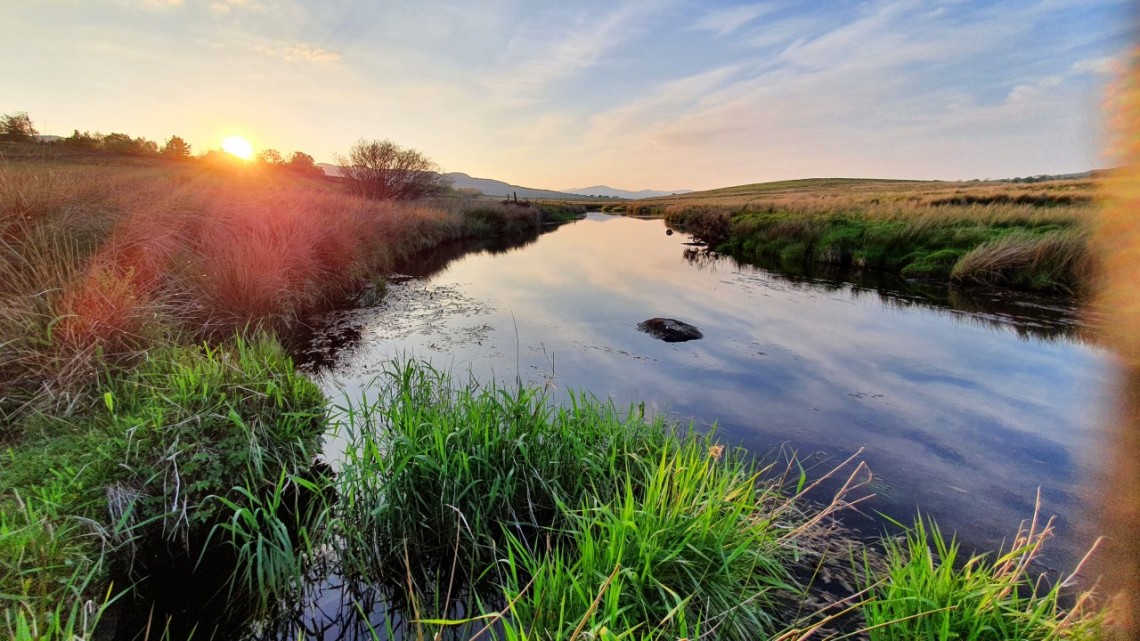 Sunset on the Eden - MJ from Dolgellau
Sunset on the Eden - MJ from Dolgellau